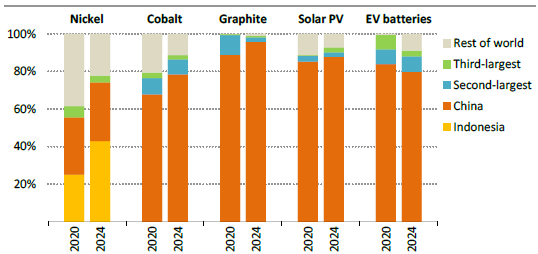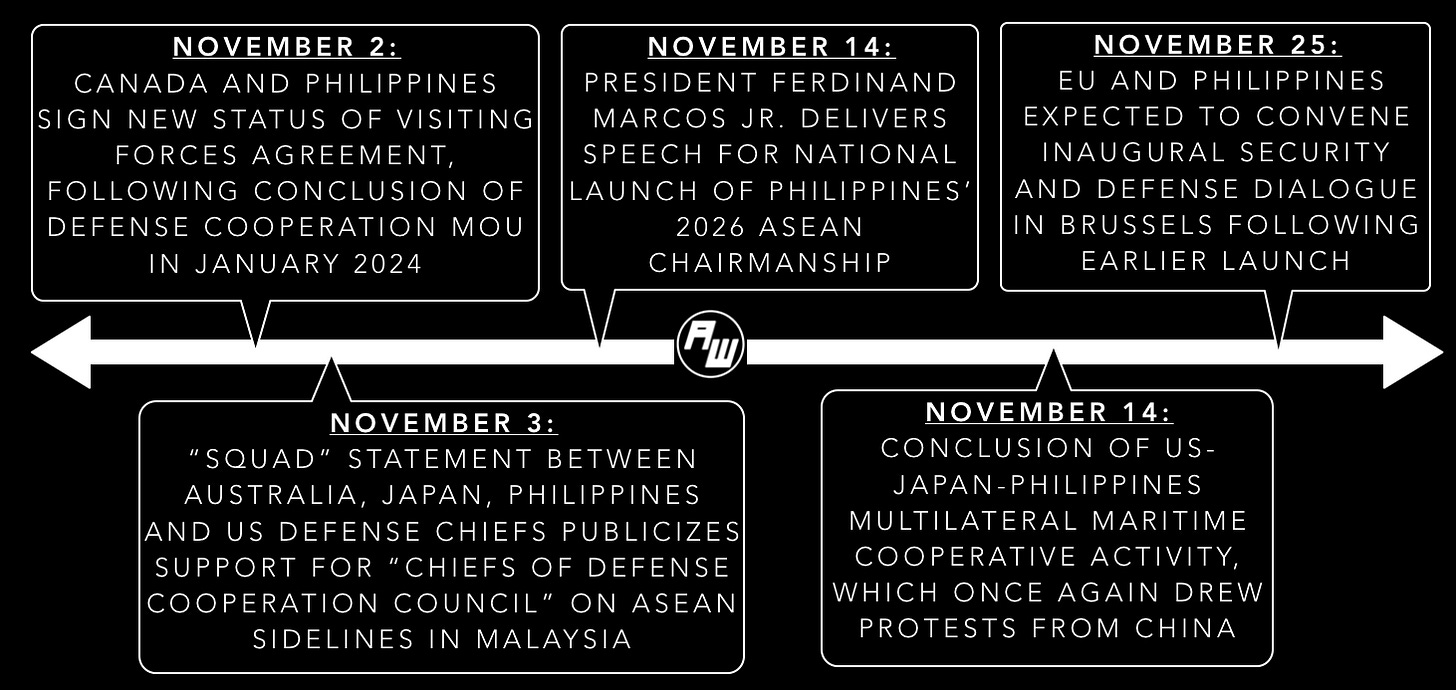What Will the Philippines 2026 ASEAN Chairmanship Look Like?
Plus coming new security agreement; space wars; new critical infrastructure datapoint; majority stake shift; quiet maritime expedition and much, much more.
Greetings to new readers and welcome all to the latest edition of the weekly ASEAN Wonk BulletBrief! If you haven’t already, you can upgrade to a paid subscription for $5 a month/$50 a year below to receive full posts by inserting your email address and then selecting an annual or monthly option. You can visit this page for more on pricing for institutions, groups as well as discounts. For current paid subscribers, please make sure you’re hitting the “view entire message” prompt if it comes up at the end of a post to see the full version.
For this iteration of ASEAN Wonk BulletBrief, we are looking at:
Assessing the geopolitical and geoeconomic significance of the Philippines’ coming chairmanship of ASEAN in 2026, and the wider regional and global implications on issues including the South China Sea;
Mapping of regional developments, including a coming new security agreement and conflict spillover threat;
Charting evolving geopolitical, geoeconomic and security trends such as critical infrastructure launch; stake shifts; and changing law enforcement links;
Tracking and analysis of industry developments and quantitative indicators including new regional payment connections; quiet maritime expedition; tracking criminal hubs and more;
And much more!
This Week’s WonkCount: 2,243 words (~10 minutes)
Coming New Security Agreement; Spillover Threat & More

Waging Economic Warfare; Tech Dependence Risks & Energy Futures
“As policymakers embrace what many are calling economic security, they are increasingly grappling with the costs and trade-offs required in pursuing growth and competitiveness on one hand and resilience and national security on the other,” argues a new report on economic security published by the Council on Foreign Relations. With respect to the United States, the report contends that while the “age of economic warfare” has arrived, Washington “is still wielding last century’s weapons” and needs better coordination, expertise and multistakeholder cooperation to overcome this (link).
Restrictive Interventions In Various Sectors Globally
“Reducing dependence on Chinese technology can’t be achieved overnight without significant economic disruption…therefore, managing the security and economic risks— whether by accepting or prohibiting Chinese technologies and identifying alternative options—requires special care,” according to a new report released by the Australian Strategic Policy Institute. The analysis focuses on five major Indo-Pacific countries—Australia, India, Japan, Singapore and South Korea, with an emphasis on foreign ownership, control and influence (FOCI) of technology (link).
“Countries are prioritizing energy security and affordability but are reaching for different levers to achieve them,” notes a new report released by the International Energy Agency. The report argues that while energy has been elevated to a core issue of economic and national security due to developments such as critical mineral restrictions and cyber attacks on the electricity sector, responses differ among countries, with many fuel-importing countries, lean towards renewables and efficiency as solutions while others focusing more on ensuring ample supplies of traditional fuels (link).
Top Supplying Countries For Select Critical Minerals And Clean Technologies (2024 vs. 2020)
What Will the Philippines 2026 ASEAN Chairmanship Look like?
What’s Behind It
Philippine President Ferdinand Marcos Jr. officially launched the country’s 2026 ASEAN chairmanship this past week, providing a window into what to expect before the annually-rotating chairmanship is turned over to Singapore for 20271. The launch, which followed the traditional handover of the chairmanship to Marcos from Malaysia Prime Minister Anwar Ibrahim at the latest round of ASEAN summitry, came as the Philippines also continued to carry out activities with groupings of partners. This included what was publicized as the eighth maritime cooperative activity with Japan and the United States of its kind held so far this year, right after a series of defense meetings earlier this month including the “Squad” configuration which also includes Australia2. More generally, diplomats privately note it is important not to forget the setting is a marked contrast from when Manila last held the chairmanship in 2017 while coming to terms with the disruptive early phase of Rodrigo Duterte’s presidency with shockwaves radiating far beyond the region in areas like South China Sea policy.
Select Recent Key Geopolitical Developments in November 2025 Amid Transition From Malaysia to Philippines ASEAN Chairmanship
The chairmanship arguably comes with a relatively fuller plate than what might have been anticipated previously for the Philippines. As one diplomat vividly put it to ASEAN Wonk, beyond what the Philippines has in mind for its chair year, of particular note is how Manila handles “those hot potatoes passed to us”. While this tendency is par for the course in ASEAN chairmanships, amid the attention on the South China Sea, the Myanmar junta’s holding of elections planned for a phased late December kickoff out to early 2026 also means the handling of an uncertain post-election landscape has essentially been mostly shifted from Malaysia’s chairmanship year out to the Philippines. Separately, private frustration had also been building among more bullish advocates about slow pace of some outcomes in the digital space like the Digital Economy Framework Agreement with complete adoption pushed to 2026, particularly since the digital realm is a fast-moving space where even signed pacts need to be periodically updated to remain relevant in a changing landscape3.
Why It Matters
The development also pointed to priority datapoints to watch with wider regional and global implications (see originally generated ASEAN Wonk table below on notable areas to monitor and additional specifics. Paying subscribers can read on for more on what to expect and future implications in the rest of the “Why It Matters” and “Where It’s Headed” sections, along with paid-only sections of the newsletter as usual).











